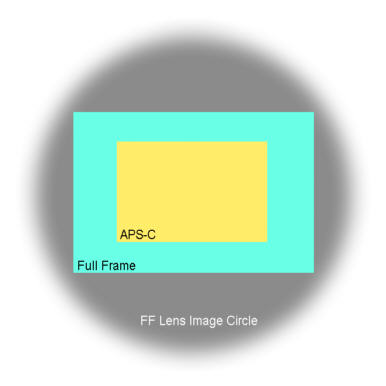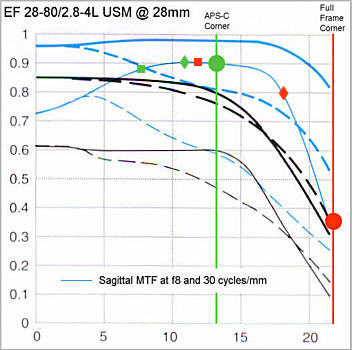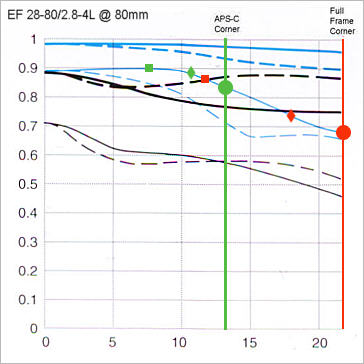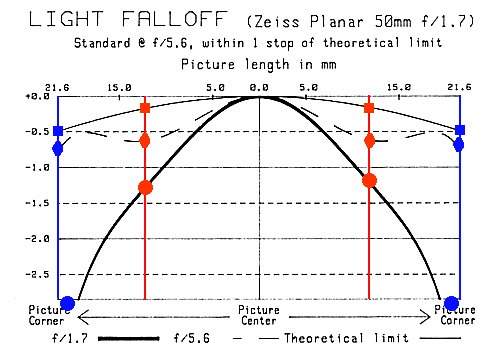
|
Canon EOS 5D vs. Canon EOS 20D - Full Frame vs. APS-C Sensors[See also a technical comparison of the EOS 5D vs. EOS 20D]The cost of dgital sensors resulted in all of the early DSLRs and most of the current DSLRs using sensors that are smaller than a traditional frame of 35mm film (36mm x 24mm). Many camera makers tried to rationalize this by telling customers that the smaller frame size was just as good and that a smaller frame size would mean smaller, lighter, cheaper cameras and lenses. Well, of course, as it turned out, they really aren't smaller, lighter or cheaper than traditional 35mm camera bodies and optics! While other camera makers have yet to produce an economically and technically viable full (24mm x 36mm) frame DSLR, Canon have two, the EOS 5D and the EOS 1Ds Mk II. In fact Canon have said that they intend to eventually go the full frame route for all their DSLRs except for entry level models, which will stay with the current "APS-C" sensor (approx 15mm x 22.5mm). Nikon are sticking with APS-C, but I suspect the reason for that is they can't get full frame sensors at a price which they can afford and still produce a competitive camera. Canon make their own CMOS sensors, which gives them a significant advantage. There has been some talk of whether APS-C sized sensor cameras, such as the EOS 20D are "enough" and whether there's any need for full frame. This talk often comes from non-Canon users who don't have the option! The question here is whether the image quality of a full frame sensor will be higher than that of an APS-C sensor, given real lenses which have imperfections.
The TheoryFirst let's look at the theoretical side of things (later we'll look at real images). For a full frame 35mm lens the image is actually a circle of at least 43mm diameter. It's sharp in the center and tends to "fuzz out" at the edges. Making the image circle larger cost money and makes the lens larger and more complex, so manufacturers tend to make the image circle just large enough for a 35mm frame (shown in light blue in the diagram below). Sometimes this means image quality at the corners isn't as good as it might be. A more expensive lens might have a slightly larger image circle and better quality at the positions of the 35mm frame corners.APS-C sensors are quite a bit smaller than full frame (15x22.5mm vs. 24x36mm) and so only the center (or "sweet spot") of the image circle. So in many cases, the image quality at the position corresponding to the corner of an APS-C sensor is higher than that corresponding to the corner of a full frame 35mm sensor.
Aberrations (imperfections) in images usually vary with the distance from the center of the frame, in the manner shown in the table below for simple lenses.
This table shows how the most common aberrations vary with off axis distance (h) and the resulting difference in aberration strength between Full Frame and APS-C. Of course this is for a simple lens. Modern photographic optics are complex and the designers go to great pains to minimize all aberrations. However it does show that aberrations may go up faster with distance than a linear relationship would predict. This means that although FF is 1.6x larger than APS-C, aberrations may be more than 1.6x greater at similar field positions (top/edge/corner). Of course if a lens were perfectly corrected for full frame then 1.6x (or 2.6x or 4.1x) no aberration = no aberration, but there are no perfect lenses! Below is an MTF plot for a real lens (The EF 28-70/2.8-4L USM at 28mm) taken from the Canon publication "Lens Work".
This is a rather complex plot, showing MTF as a function of distance from the center of the frame under various conditions. However let's just look at the thinner solid blue line for now. This represents the Sagittal MTF (MTF for lines pointing towards the center of the frame) at f8 for a spatial frequency of 30 cycles/mm. If this doesn't mean much to you, just think of it as a plot of sharpness vs. distance from the center of the frame and you won't be too far wrong. The green line is the distance of the corner of an APS-C frame from the center (13.5mm) and the red line is the distance of the corner of a full 35mm frame from the center (21.5mm). You can see that for an APS-C frame corner the MTF is about 0.9 (green dot), while for a 35mm full frame it's about 0.35. If we look at the left/right frame edge we can see that for APS-C we have 0.9 (green diamond) and for full frame 35mm we have 0.8 (red diamond). If we look at the top and bottom edges, the MTF for the APS-C frame is about 0.88 and for the full 35mm frame it's 0.9. The other lines on the plot are for different conditions (f2.8, 10 cycles/mm, tangential MTF), but it's clear that they all show similar behavior insofar as MTF (sharpness/contrast) is a function of off-axis distance and MTF tends to be (though isn't always) lower the further away from the center you go. Things often look better at longer focal lengths though. Aberrations are a little easier to correct with telephotos than with wideangles.
VignettingAnother image aberration which depends on off axis distance is vignetting. Vignetting comes from two sources. One is the so called "Cos4Theta" falloff which is an intrinsic property of the lens optics. It's the line marked ("theoretical limit") on the plot below and it's the lowest value that vignetting can take. The other source is geometric vignetting due to the way a practical lens is constructed. This type of vignetting strongly depends on aperture. The diagram below illustrates an actual case and comes from an article in "Modern Photography" from a few decades ago!
The blue lines represent the corners of a full 35mm frame, the red lines represent the corners of an APS-C frame.Wide open you can see that the corners of the full frame vignette by maybe 3 stops compared to the center (blue circle). This is a significant and quite visible amount of vignetting, but it's typical for a fast normal lens. At the corners of the APS-C frame, vignetting is only about 1.25 stops (red circle), which is a lot better. Stopped down to f5.6 the full frame vignetting drops to about 0.75 stops (blue diamond) and APS-C vignetting drops to about 0.65 stops. Stopped down further, the full frame vignetting will approach the theoretical cos4 limit of 0.5 stops (blue square) and the APS-C vignetting will approach about 0.15 stops (red square). Sensor SizeClearly the physical size of the sensor is a factor in image quality, but equally clearly it's not the only factor. To take an absurd example, a Full Frame sensor with 100,000 (or even 1 million) pixels isn't going to better the image quality of an APS-C sensor with 10 million pixels. So pixels count too. Exactly how much they count is another complex subject, but let's just say that if you have the same number of pixels, then the larger sensor can give higher quality images, and if you have more pixels, then you're in even better shape. There could conceivably be situations when a larger sensor with somewhat fewer pixels could give better quality, but let's not get into that one! In the article Digital Sensor Size - Why Size Matters I go into the issues of sensor size in some detail and describe how larger sensors work on the upper part of the MTF curve of a lens, while smaller sensors work on a lower part of the curve. However for the sake of argument, lets say that both Full Frame and APS-C sensors work on a part of the curve where the lens MTF is pretty high. Lets look at a 12.7 MP full frame sensor, like the on in the 5D, and an 8.2 MP sensor like the one in the 20D.
The MTF (contrast/sharpness) of a lens will be higher at 61 lp/mm than at 78 lp/mm and even though the native resolution of the APS-C sensor is higher, the resolution in the final print is lower. For example to get to a 12" x 18" print you have to enlarge a full frame image by a factor of 12.7x and an APS-C image by a factor of 20.3. That means that the native resolution of the full frame sensor (61 lp/mm) becomes 4.8 lp/mm in the print and the native resolution of the APS-C sensor (78 lp/mm) becomes 3.85 lp/mm in the print. In other words, despite the lower resolution of the sensor, the resolution in a print of any given size will be higher. Full frame wins!
NEXT: [Part II - Test Images]
© Copyright Bob Atkins All Rights Reserved |
|||||||||||||||||||||||||||||||||||||||||||||||||||||||



